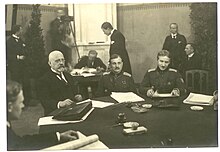Treaty of Tartu (Estonia–Russia)
Additionally RSFSR agreed to grant concessions to exploit one million hectares of Russian forest land and to build a railway line from the Estonian border to Moscow.[4] The treaty was signed by Jaan Poska on the Estonian side and Adolf Joffe for Soviet Russia, as well as by other representatives of both parties.[citation needed] The Tartu Peace Treaty has been regarded as the birth certificate of the Republic of Estonia because it was the first de jure recognition of the state.For example, the museological collections of the University of Tartu have not been returned to this day from Voronezh[6] and the migration of Estonians was obstructed.The Estonia–Russia border today leaves some land granted to Estonia by the Treaty of Tartu under Russian control.

Adolph JoffePeace treatyEstoniaSoviet RussiaEstonianRussianRepublic of EstoniaEstonian War of IndependenceBolshevikImperial RussiaWorld War IGerman EmpiresrublesRussian EmpireJaan PoskaJaan SootsVictor MuttAdolf Joffede jureEntenteUniversity of TartuVoronezhoccupiedSoviet UnionEstonia–Russia borderWikisourceLatvian–Soviet Peace TreatySoviet–Lithuanian Peace TreatyTreaty of Tartu (Finland–Russia)Peace of RigaÜlo Kaevats